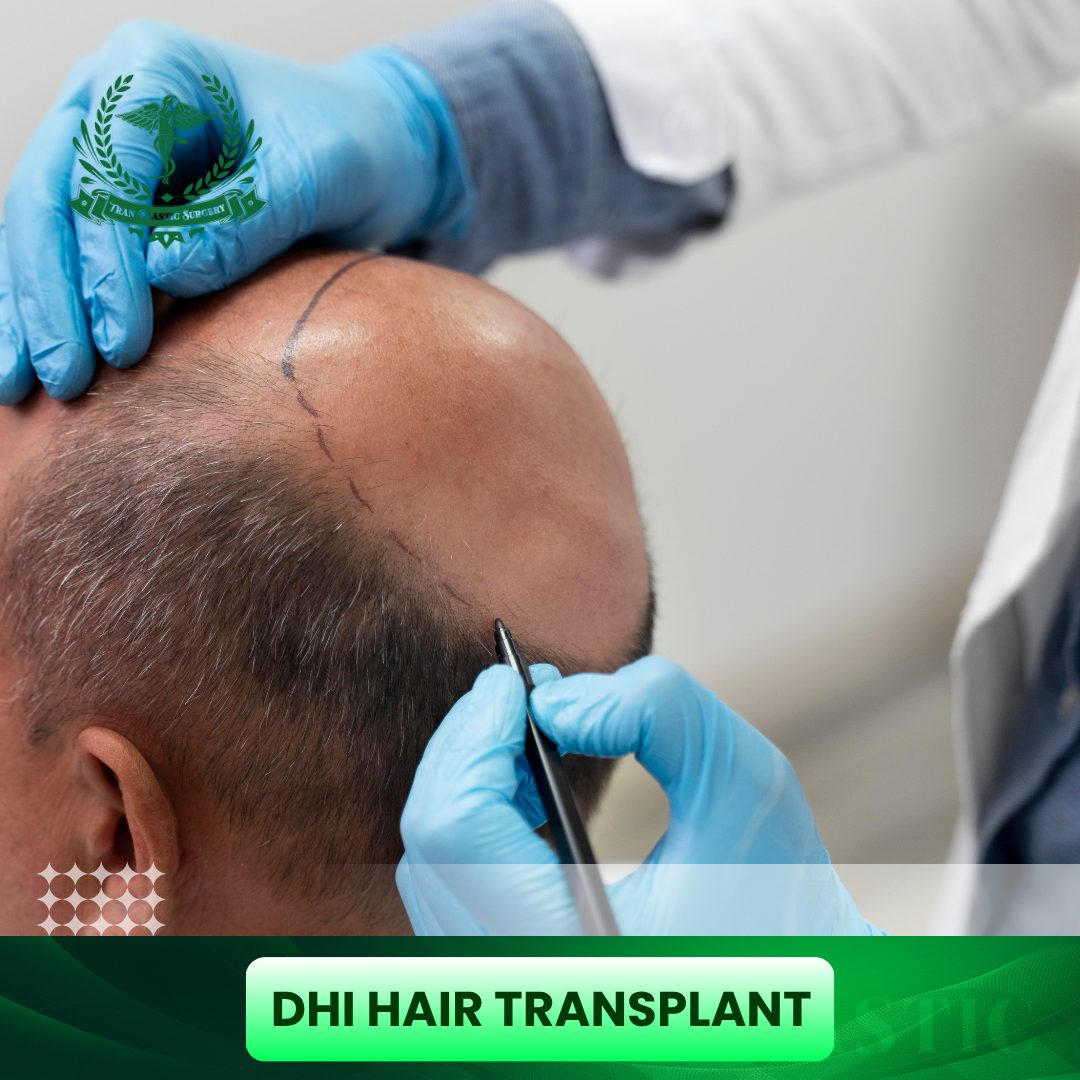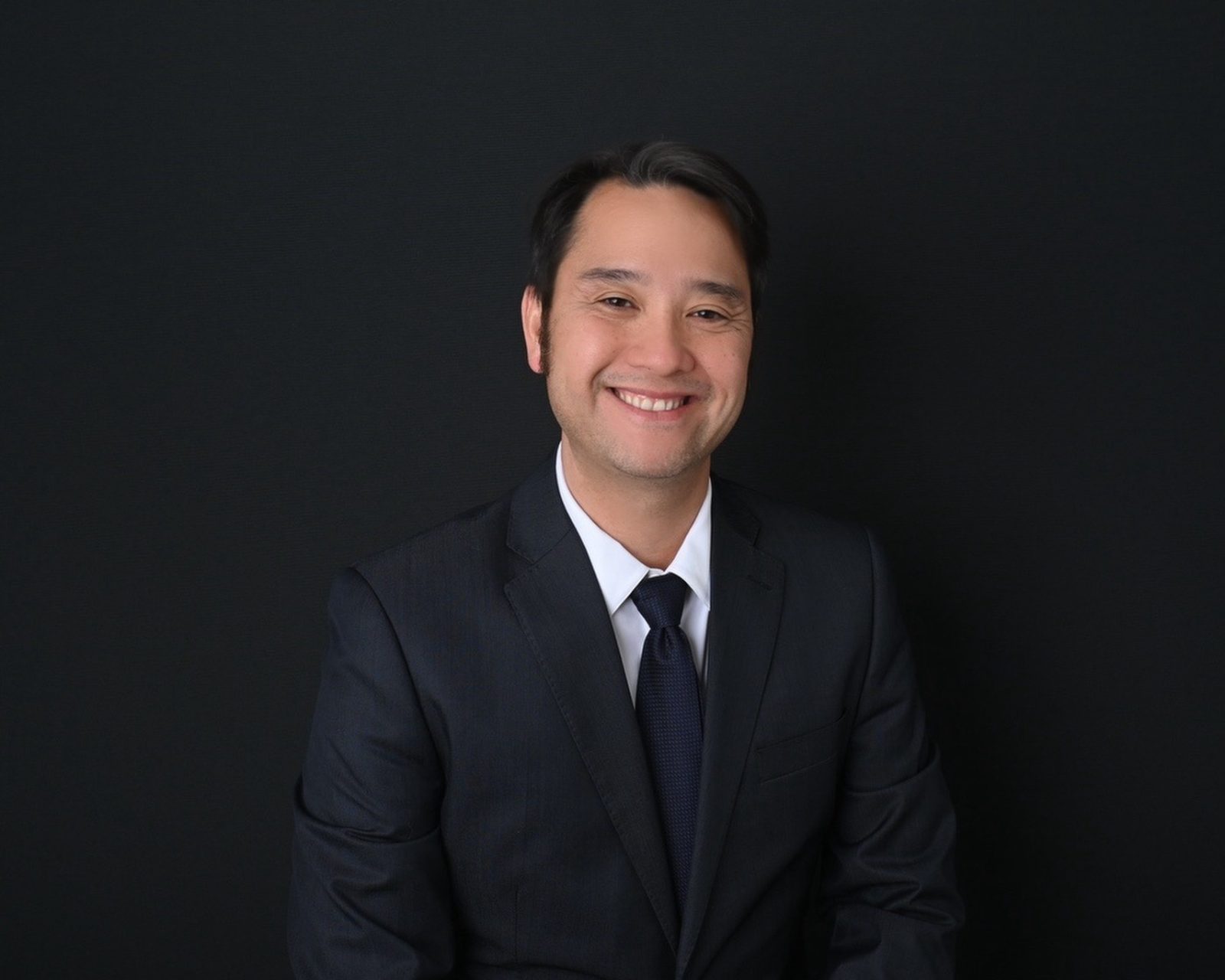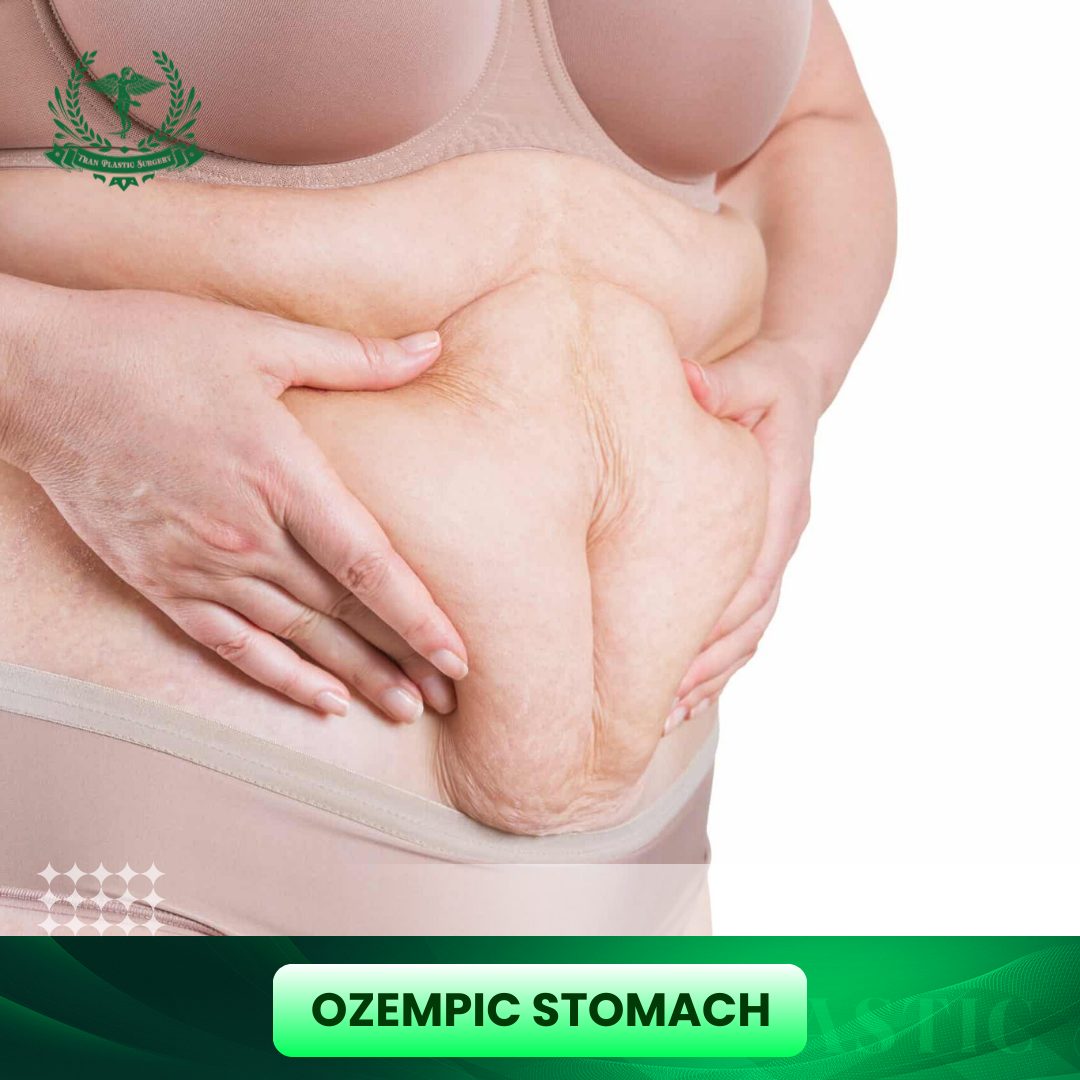DHI hair transplant is redefining the way people restore natural, permanent hair growth through precision and innovation. This advanced technique, known as Direct Hair Implantation, offers higher density, faster recovery, and more natural results than traditional methods like FUE or FUT. In this guide of Tran Plastic Surgery expert, you’ll discover how the DHI procedure works, its benefits, recovery process, cost comparisons, and expert tips to help you decide if it’s the right solution for your hair restoration goal.This article provides everything you need to make an informed and confident decision about your DHI hair transplant journey.
Table of Contents
ToggleWhat Is a DHI Hair Transplant?
A DHI hair transplant, or Direct Hair Implantation, is a state-of-the-art hair restoration technique designed to achieve fuller, more natural-looking results with minimal downtime. Unlike traditional transplant methods that involve creating incisions or channels before implantation, the DHI procedure uses a specialized tool known as the Choi Implanter Pen. This instrument allows the surgeon to extract and implant hair follicles simultaneously, giving them complete control over the angle, depth, and direction of each graft.
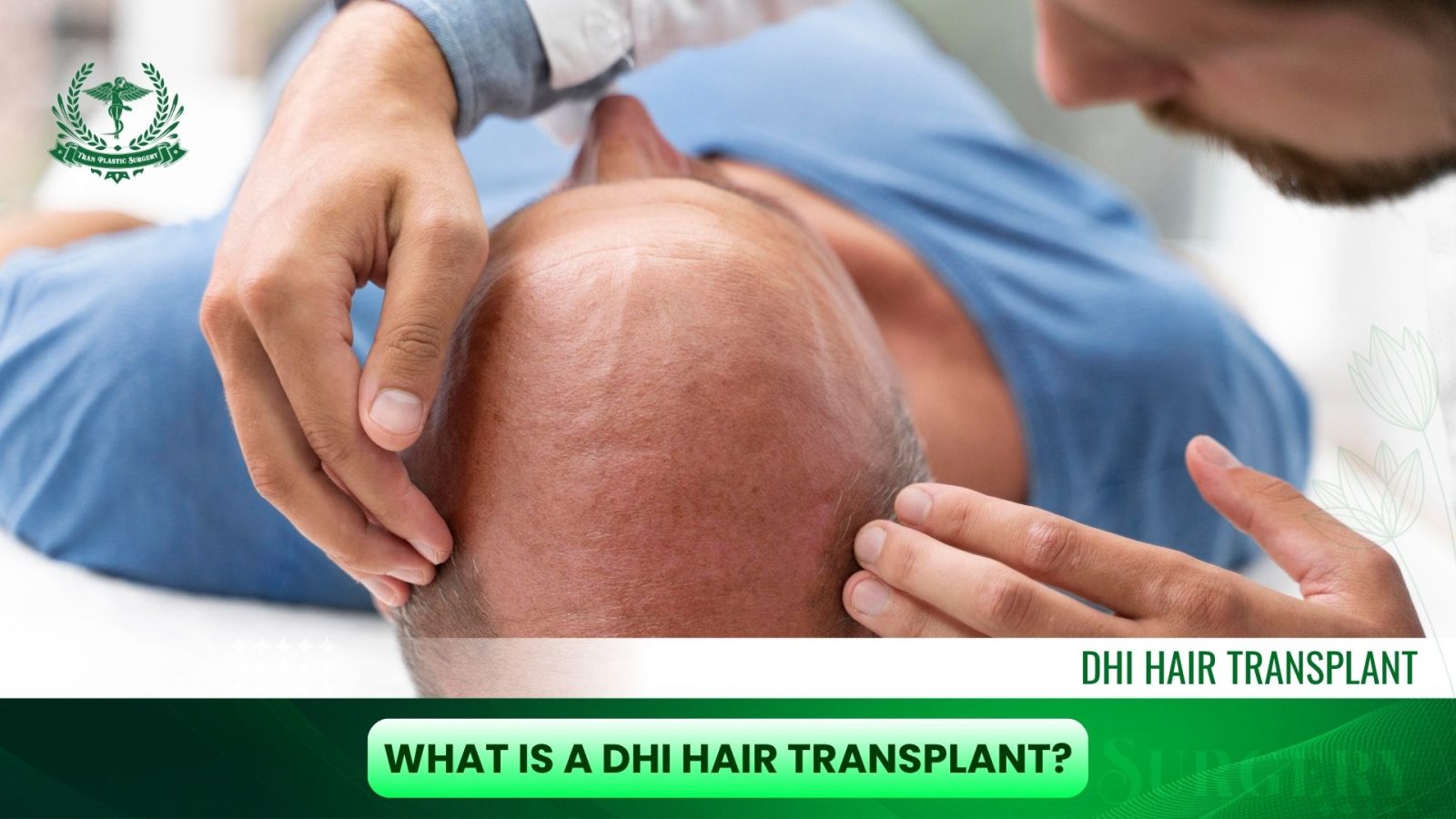
This method ensures high precision and better graft survival rates while reducing trauma to the scalp. As a result, patients experience faster healing, less scarring, and a more refined aesthetic outcome. The DHI hair transplantation approach is particularly popular among individuals seeking denser coverage in areas such as the hairline, crown, or temples, where natural direction and volume are essential.
Compared to FUE (Follicular Unit Extraction) or FUT (Follicular Unit Transplantation), DHI offers greater control and improved results without requiring extensive recovery time. It combines advanced technology with medical artistry, making it one of the most trusted and effective options for anyone considering a permanent solution to hair loss.
DHI vs. FUE – Which Technique Is Best?
When exploring modern hair restoration, it’s essential to understand how a DHI hair transplant differs from other popular procedures like FUE (Follicular Unit Extraction). Each method has unique advantages, recovery times, and aesthetic outcomes. Knowing these differences helps patients make informed decisions that align with their goals, hair type, and budget.
1. DHI (Direct Hair Implantation)
The DHI method uses the Choi Implanter Pen, allowing surgeons to extract and implant hair follicles in one continuous motion. This technique minimizes scalp trauma, preserves graft viability, and ensures precise control over the direction and density of implanted hairs. Patients often experience quicker healing, less scarring, and highly natural results making DHI one of the most advanced techniques available today.
2. FUE (Follicular Unit Extraction)
The FUE technique involves manually extracting individual follicular units and implanting them into pre-made incisions. It provides excellent results but requires more handling of the grafts, which can slightly increase healing time. FUE is widely recognized for its versatility and minimal scarring, but it may offer less control over graft angle and placement compared to DHI.
3. Which Technique Should You Choose?
For patients seeking the most natural-looking results with faster recovery and less visible scarring, DHI hair transplantation is often the preferred choice. FUE remains an excellent alternative for those who prioritize affordability or do not require ultra-high density. In summary, while all two techniques can effectively restore hair, DHI stands out for its precision, comfort, and superior aesthetic control making it an excellent investment for long-term satisfaction.
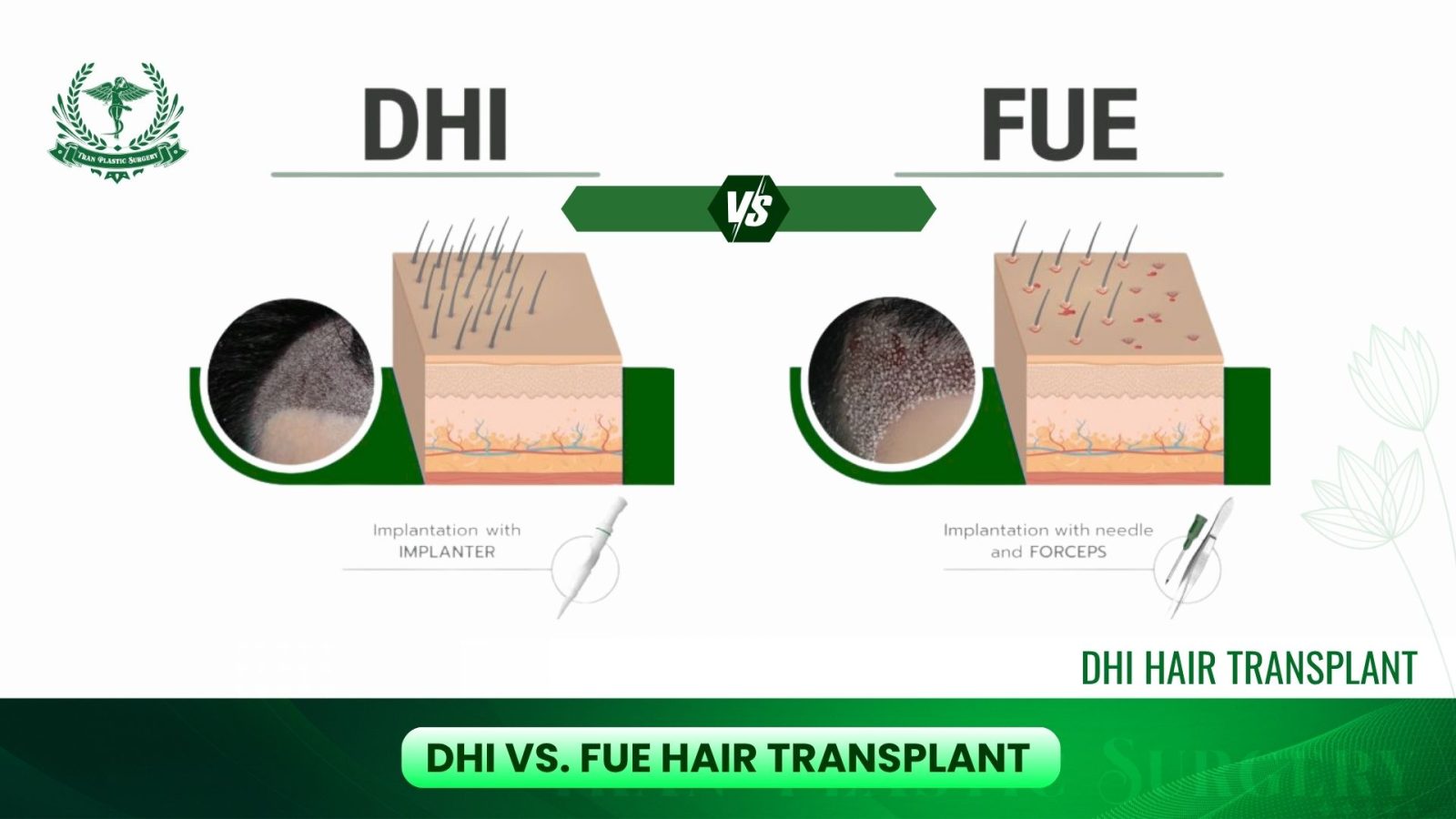
>>> Immediately see the effectiveness of the new FUT Hair Transplant method for patients
Step-by-Step DHI Hair Transplant Procedure
Understanding the DHI hair transplant procedure helps patients appreciate why this method is considered one of the most precise and advanced hair restoration techniques available today. Each stage of the process is carefully designed to protect graft health, minimize trauma, and deliver natural-looking density.
Step #1: Consultation and Hair Analysis
The first stage begins with a detailed scalp examination and hair density analysis. A qualified specialist evaluates the donor and recipient areas using digital imaging tools to determine graft quantity and pattern. This personalized assessment ensures that the DHI hair transplantation plan aligns with each patient’s natural hairline and aesthetic goals.
Step #2: Donor Hair Extraction with the Choi Implanter Pen
Unlike traditional methods, the DHI technique uses a Choi Implanter Pen to extract follicles one by one without creating incisions. This innovative device minimizes scalp damage and preserves graft vitality. Each follicle is immediately prepared for implantation, reducing the time it spends outside the body and increasing its survival rate.
Step #3: Graft Preservation and Preparation
The harvested follicles are kept in a nutrient-rich solution to maintain their strength and viability. Skilled technicians separate and prepare the grafts based on size and quality. This step is crucial for achieving even density and a natural transition between the implanted and existing hair.
Step #4: Direct Hair Implantation
The surgeon implants each follicle directly into the scalp using the same Choi pen, controlling the angle, depth, and direction for every graft. Because there are no pre-made incisions, the procedure minimizes bleeding and promotes faster healing. This level of control gives DHI hair transplant results their characteristic natural appearance and high density.
Step #5: Post-Procedure Evaluation and Aftercare
Once implantation is complete, the surgeon examines the treated area to ensure uniform coverage. Patients receive personalized aftercare instructions to support healing and maximize growth. Mild redness or swelling may appear for a few days but typically subsides quickly, allowing patients to return to regular activities sooner than with other transplant methods.
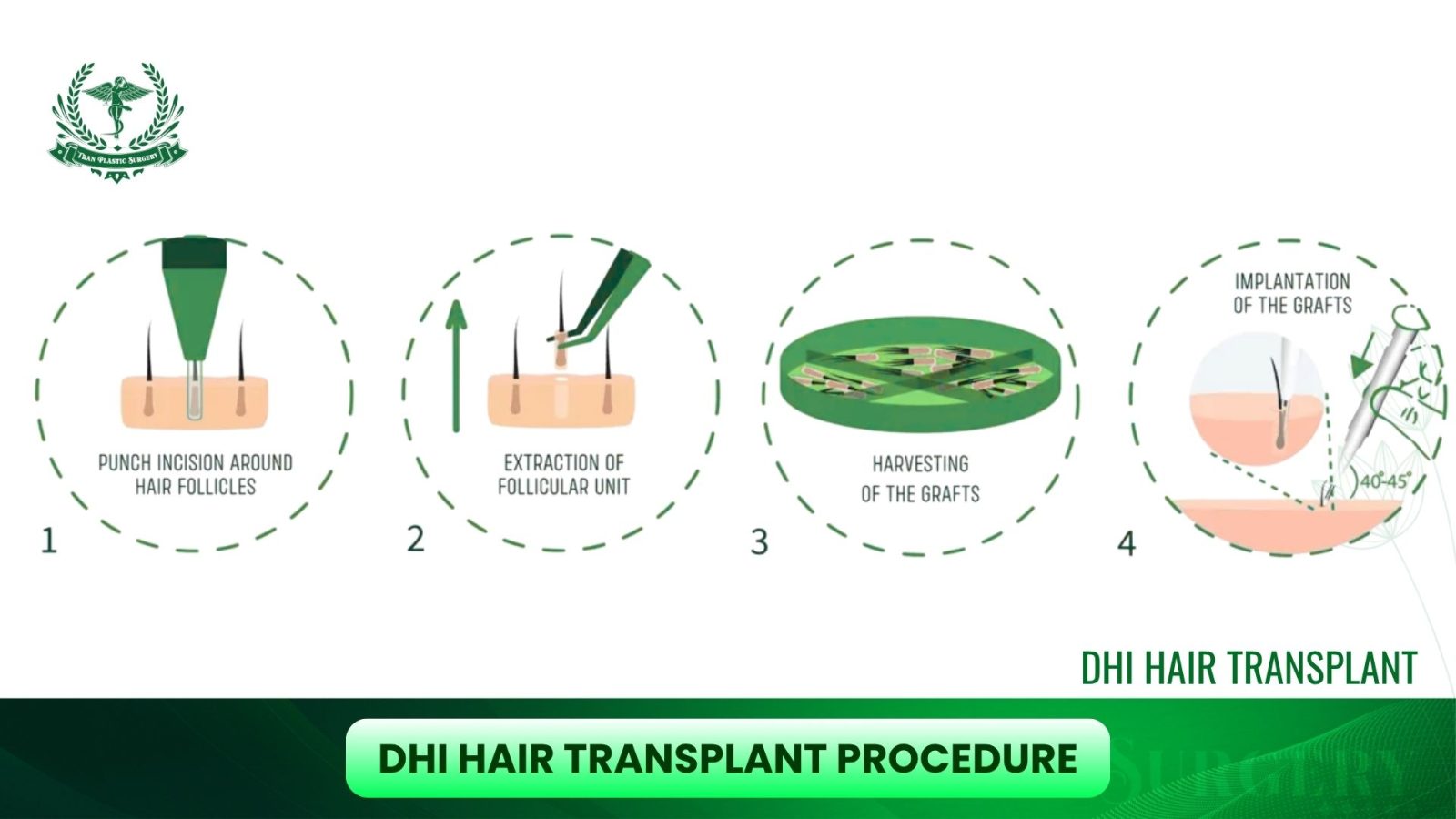
A DHI hair transplant combines cutting-edge technology with medical expertise, ensuring both precision and comfort throughout the process. Each stage from analysis to aftercare is executed under strict clinical standards, giving patients a safe and effective path to permanent, natural-looking hair restoration. If you are still unsure or have many questions about this service, do not hesitate to contact Tran Plastic Surgery immediately for advice.
DHI Hair Transplant Recovery & Aftercare
Proper recovery and aftercare are essential to achieving the best possible results after a DHI hair transplant. This stage determines how well the transplanted follicles adapt and begin growing naturally. Since the DHI method causes minimal trauma to the scalp, patients typically experience a shorter healing time and less discomfort than with traditional hair transplant techniques.
1. Week-by-Week Recovery Timeline
1 Week After DHI Hair Transplant
During the first week, the scalp may appear slightly red or swollen, which is a normal part of the healing process. Tiny scabs form around the implanted follicles and will naturally fall off within a few days. Gentle washing using mild shampoo and cool water is usually recommended after 48–72 hours. Most patients can resume daily routines with minimal restrictions.
1 Month After DHI Hair Transplant
By the first month, most signs of surgery such as redness and sensitivity have faded. Some patients may experience temporary “shock loss,” where transplanted hairs shed before regrowth begins. This is entirely normal, as the follicles enter a resting phase before producing new, healthy strands.
2 Months After DHI Hair Transplant
At the two-month mark, early regrowth starts to appear. The new hair is often fine and soft, gradually thickening over time. Consistent care, a balanced diet, and avoiding harsh hair products are crucial during this stage to support optimal recovery and natural density.
2. DHI Hair Transplant Aftercare Tips
- Keep the scalp clean and protected from direct sunlight for at least two weeks.
- Avoid strenuous physical activity for 7–10 days to prevent excess sweating.
- Do not scratch or pick at the transplanted area to avoid dislodging new grafts.
- Sleep with your head elevated for the first few nights to reduce swelling.
- Follow your surgeon’s recommendations regarding medication and scalp care products.
3. Managing Side Effects and Shock Hair Loss
Minor side effects such as mild swelling, redness, or temporary shedding can occur after a DHI hair transplantation. These are short-term and typically resolve within weeks. The implanted follicles remain secure under the skin and will soon produce new hair that grows naturally. Patients should also be aware that shock hair loss is part of the body’s adjustment process and not a sign of failure.
With careful post-operative care, most patients can expect noticeable improvements within three to four months, with full results visible between nine and twelve months after surgery.
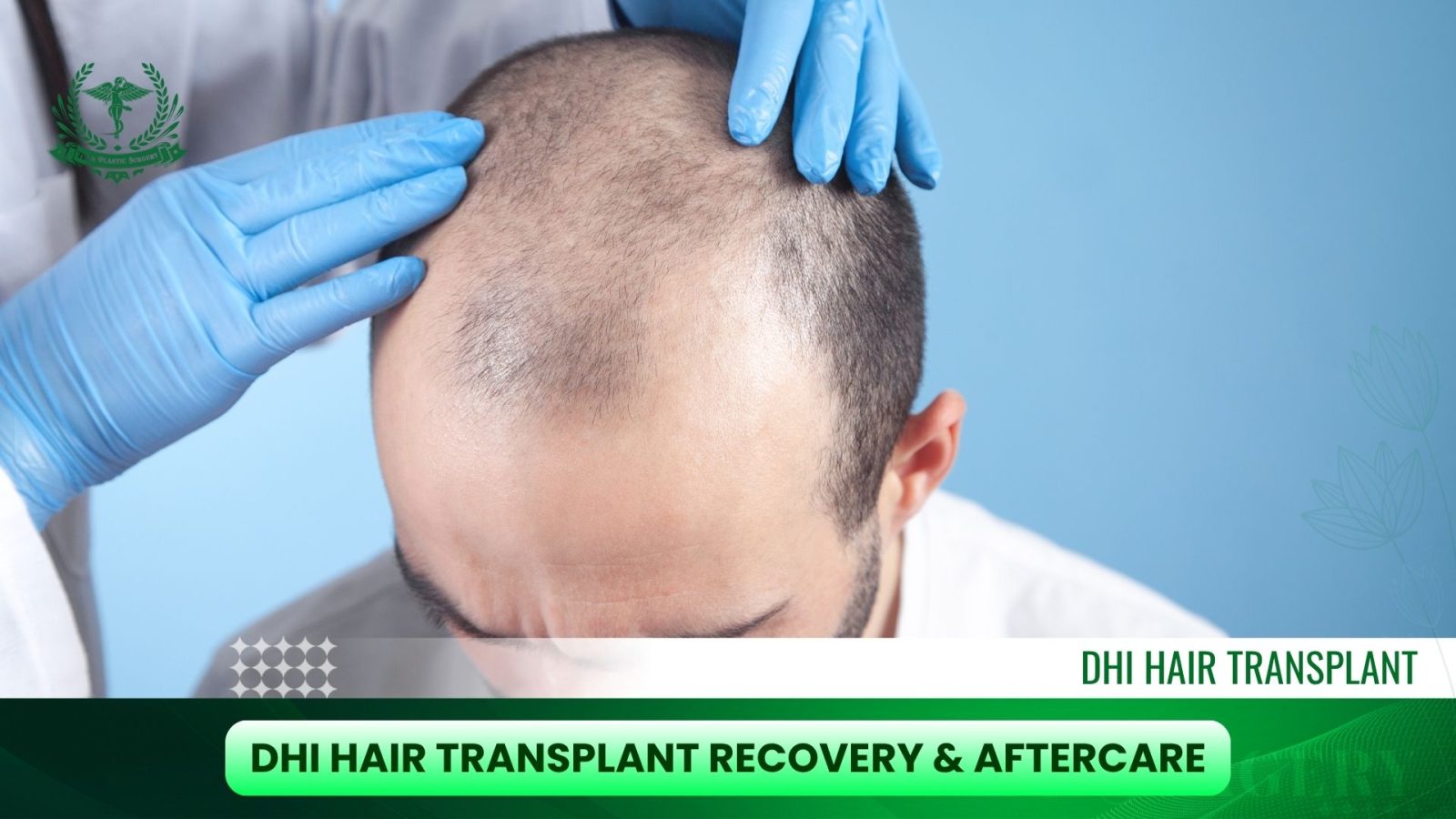
DHI Hair Transplant Before and After Results
The visual transformation after a DHI hair transplant often speaks louder than words. Patients typically notice early signs of new growth within three months, with full density achieved after nine to twelve months. The results are characterized by a natural hairline, consistent density, and a smooth blend between transplanted and existing hair.
Each outcome depends on several factors, including donor hair quality, surgeon expertise, and adherence to post-operative care. When performed by an experienced specialist, DHI hair transplantation can restore both appearance and confidence through results that look completely natural.
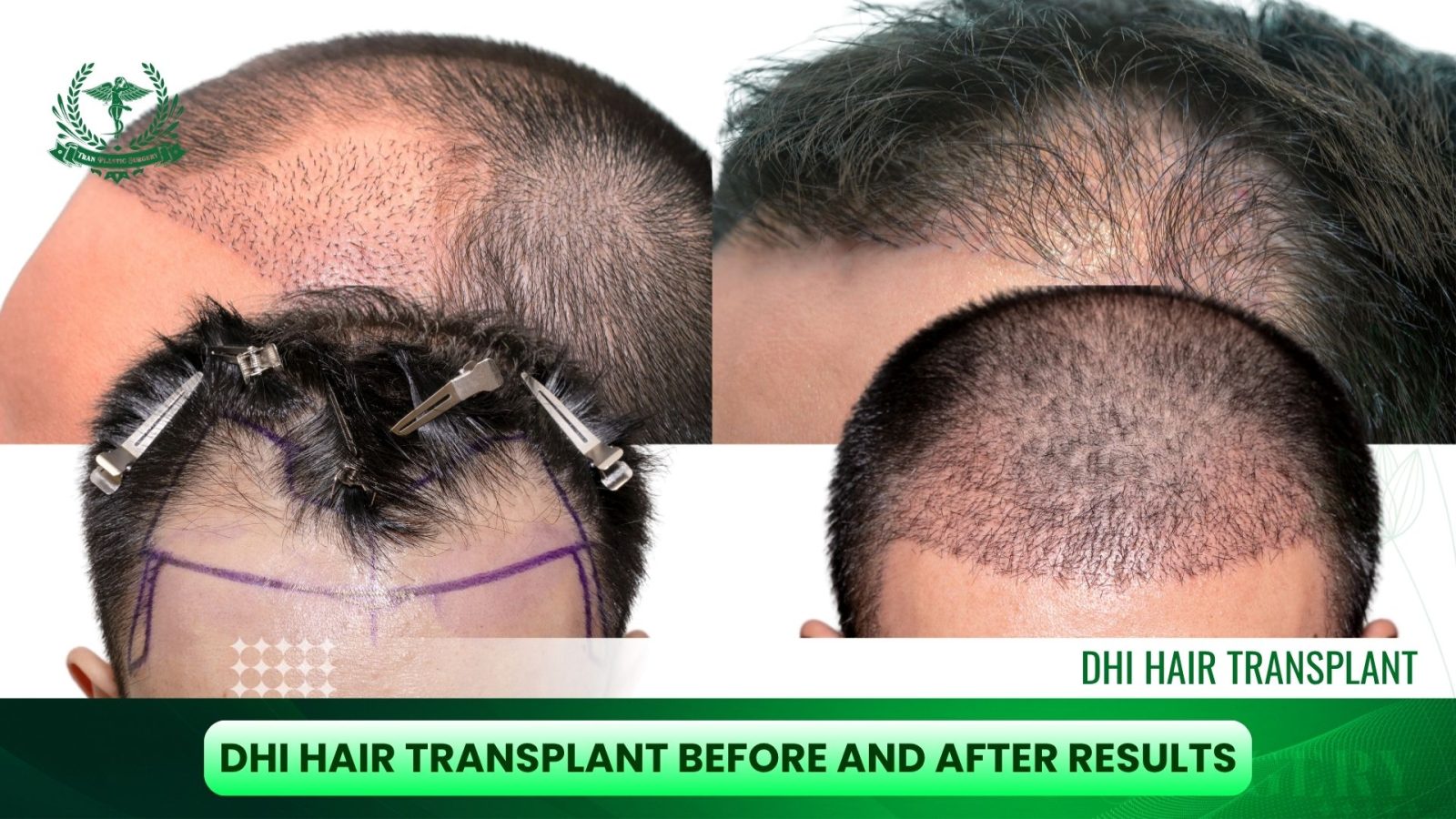
DHI Hair Transplant Cost (U.S. & Global Comparison)
The cost of a DHI hair transplant varies significantly depending on location, clinic reputation, surgeon expertise, and the number of grafts required. Because DHI involves advanced technology and a more time-intensive implantation process, it generally costs more than traditional FUE or FUT procedures.
In the United States, prices typically range from $3,500 to $12,000, depending on the scope of treatment and clinic location. Major cities like Los Angeles and New York often charge higher fees due to medical facility standards and surgeon demand. Patients seeking affordability sometimes explore international destinations, especially Turkey, India, or Thailand, where world-class clinics offer the same DHI technique at lower prices ranging from $1,800 to $4,000 on average.
Several factors influence the final DHI hair transplant price, including:
- Graft count: The more follicles transplanted, the higher the cost.
- Clinic reputation: Accredited or internationally recognized centers often charge a premium.
- Surgeon experience: Highly trained specialists tend to command higher fees.
- Technology and facilities: Clinics using certified Choi Implanter systems and advanced graft preservation protocols may cost more but deliver superior results.
Average DHI Hair Transplant Cost by Country
| Country | Average Cost (USD) | Notes |
| USA | $3,500 – $12,000 | Premium pricing; experienced surgeons |
| UK | $4,000 – $8,000 | Strong regulatory standards |
| Turkey | $1,800 – $4,000 | Affordable, globally popular destination |
| India | $1,500 – $3,000 | Cost-effective with skilled surgeons |
| Thailand | $2,000 – $4,000 | Competitive packages for international patients |
Choosing the cheapest DHI hair transplant option is not always ideal. Prioritize clinic safety, surgeon credentials, and patient reviews over low pricing. A well-executed DHI procedure offers permanent, natural-looking results that justify the investment.
If you’re looking for a trusted DHI hair transplant service in California at a fair price, visit Tran Plastic Surgery or call (714) 839-8000 – (714) 530-5888. Our board-certified specialists combine advanced DHI technology with personalized care to deliver results that look natural, feel authentic, and last a lifetime.
Alternatives to DHI Hair Transplant
A DHI hair transplant is one of the most advanced solutions for restoring hair permanently, but it isn’t the only option. For patients seeking non-surgical approaches, several proven treatments can help reduce hair loss and promote regrowth.
Finasteride is a prescription pill that lowers DHT levels, the hormone linked to male pattern baldness. Minoxidil, available as a topical spray or foam, increases blood flow to the scalp and stimulates new growth. Many specialists recommend combining the two for stronger, faster results.
Other effective alternatives include PRP therapy, which uses your own plasma to reactivate follicles, and low-level laser therapy, a non-invasive method that improves scalp circulation. Supplements rich in biotin and zinc may also support healthier hair growth.
Choosing the Right Clinic or Surgeon for DHI Hair Transplant
Selecting the right specialist is the most important step in achieving excellent DHI hair transplant results. The surgeon’s skill, experience, and understanding of natural hair growth patterns directly influence the outcome. A qualified professional ensures that each graft is implanted at the proper angle, depth, and direction to create a seamless and realistic appearance.
When evaluating clinics, always consider the surgeon’s credentials, past patient results, and the technology used. Look for facilities that specialize exclusively in hair restoration and maintain strict safety and hygiene standards. Transparency about the procedure, costs, and recovery timeline is another sign of a trustworthy practice.

In California, Dr. Tuan Tran of Tran Plastic Surgery is recognized for his meticulous approach and dedication to advanced hair restoration techniques. His team combines medical precision with aesthetic artistry to deliver natural, lasting results through modern DHI hair transplantation. Patients appreciate not only his technical expertise but also his commitment to personalized care and realistic outcomes.
FAQs About DHI Hair Transplants
1. How long does recovery take after a DHI hair transplant?
Most patients recover within 5 to 7 days, with minor redness or swelling that fades quickly. Full results typically develop between 9 to 12 months as new hair grows and thickens naturally.
2. Is DHI better than FUE or FUT?
Yes, in many cases. While FUE and FUT are effective, DHI offers higher precision, faster healing, and a more natural outcome. However, the best method depends on your hair type, scalp condition, and treatment goals factors your surgeon will evaluate during consultation.
3. Does a DHI hair transplant cause pain or scarring?
The procedure is performed under local anesthesia, so discomfort is minimal. Since no incisions or stitches are made, DHI hair transplantation leaves virtually no visible scarring, even in short hairstyles.
4. Can women also get a DHI hair transplant?
Absolutely. DHI is suitable for both men and women experiencing pattern baldness, thinning hair, or receding hairlines. The technique’s precision makes it ideal for delicate areas such as the frontal hairline or temples.
5. How long do DHI hair transplant results last?
Results are permanent. The transplanted follicles are genetically resistant to hair loss, meaning they continue to grow for a lifetime with proper care and maintenance.

